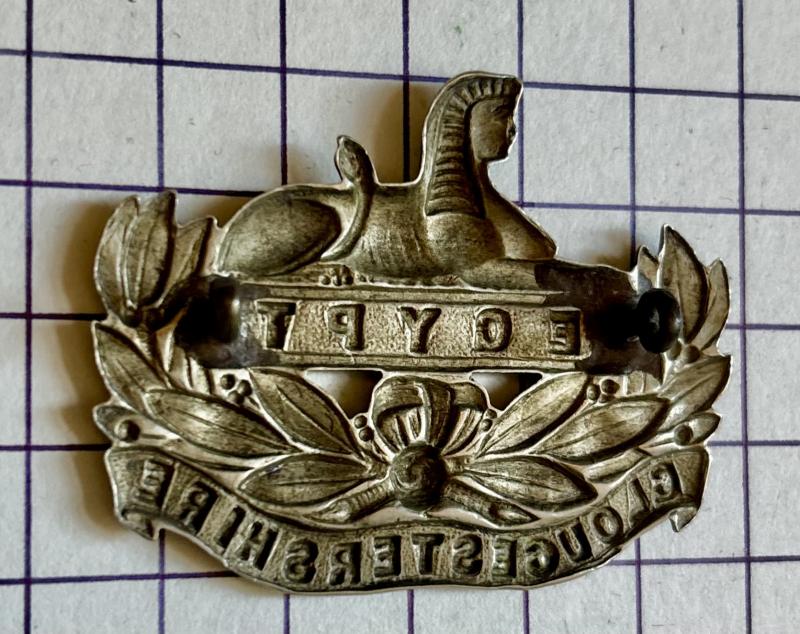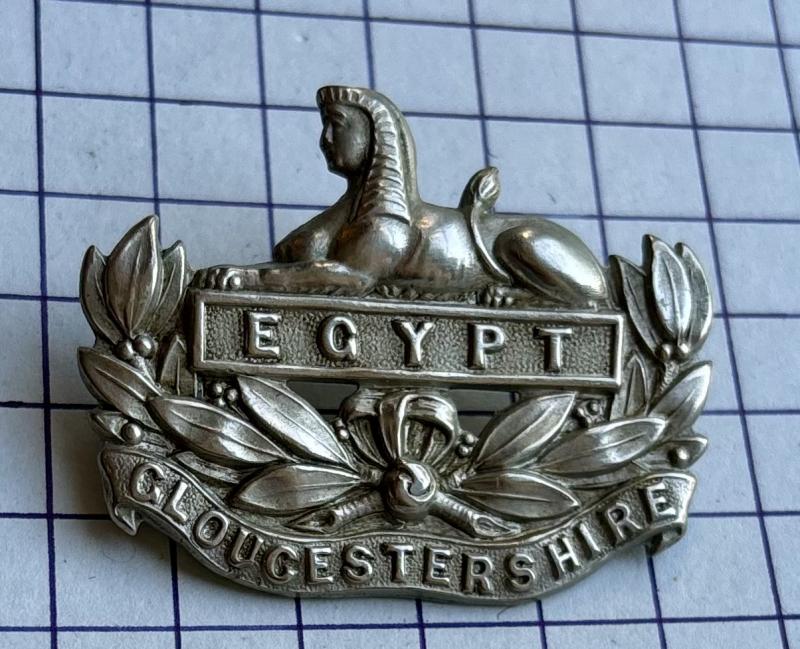c1894-1908 Victorian / Edwardian Gloucestershire Regiment Early Cap Badge
Scarce, a lovely Victorian / Boer War period, Other Ranks (ORs) Glosters cap badge. NB: with a 'higher silver mix' with copper (white metal) early version, on lovely dark Victorian era lugs. VGC.
Ref: KK634.
Before the turn of the Century, the Gloucestershire Regiment began life quietly. The two Battalions alternated between postings at home and overseas, mostly in India, but their first action came in 1899 during the Second Boer War. Deployed to Ladysmith, the 1st Battalion was part of a column sent out on 24 October to cover the withdrawal of a brigade after the Battle of Talana Hill. When the column came under fire near Rietfontein, the Battalion was detached and ordered forward, but the order was ambiguous and the battalion advanced too far. The troops were caught in the open for several hours before they were able to extricate themselves at the cost of five men killed, including the battalion commander, and 58 wounded.
Five days later, some 450 men of the 1st Battalion were part of a small force tasked with seizing Nicholson's Nek, a pass some 6 miles (10 km) north of Ladysmith, during the Battle of Ladysmith. The troops moved out on the night of 29 October with the intention to be in position before the main battle started, but they left too late to reach their objective before daybreak. As they took up an alternative position on the nearby Tchrengula Hill the pack-mules bolted, taking most of the heavy weaponry and ammunition with them. The Boers discovered the incursion at dawn and surrounded the position, and although the British held out for several hours they were forced to surrender at 12:30. The battalion lost 38 killed and 115 wounded, and the survivors were held as prisoners of war (POWs) in Pretoria.
While the remainder of the 1st Battalion helped in the defence of Ladysmith (the city was eventually relieved on 1 March), the 2nd Battalion deployed to South Africa, arriving in January 1900. The battalion fought in the Battle of Paardeberg, a nine-day battle which ended on 27 February with the capture of the Boer general Piet Cronjé and his force of some 4,000 men. On 15 March, the battalion entered the Boer city of Bloemfontein, where it remained on garrison duties until 1904. The 1st Battalion, re-united when its POWs were liberated after the capture of Pretoria on 5 July, was posted in August 1900 to Ceylon, where it remained until 1903 guarding Boer prisoners of war.
Some of the regiment's auxiliary battalions, which in 1900 were increased in number by the formation of the 3rd Volunteer Battalion, also played a role in the war. On 16 March 1900, a company of 124 officers and men from the 1st and 2nd Volunteer Battalions landed at Cape Town. They served for a year alongside the 2nd Battalion and were replaced by a second volunteer company in April 1901. The 4th (Militia) Battalion, meanwhile, guarded Boer prisoners held on St. Helena.30 By the war's end the regiment had lost 2 officers and 94 other ranks killed, 13 officers and 201 men wounded, and suffered 250 deaths from sickness. The regiment added 4 new battle honours to its colours: "Defence of Ladysmith"; "Relief of Kimberley"; "Paardeberg"; and "South Africa, 1899–1902"; the last of which was also awarded to the 1st and 2nd Volunteer Battalions.
12f
Code: 416



